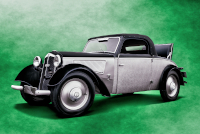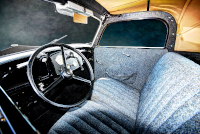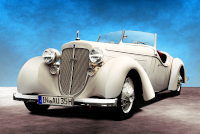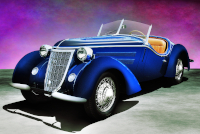Location:
Radnor Hunt Concours d'Elegance, 2013
Owner: Audi North America
Prologue:
Auto Union recalls the commercial and technical development of August Horch, Paul Daimler, and Ferdinand Porsche, giants of the German auto world. But it is a Dane, Jørgen Skafte Rasmussen, whose fledgling DKW brought the fruits of their labor under one banner.
Our glimpse at DKW production is all-too brief, but necessary. And English material being so scarce, some decent portion of this description comes from examining readily available photographs of the chassis and motor. So please excuse the paucity of detail; better to include this curious little car than neglect a foundational piece of the Auto Union story.
- - - - - - - - - -
► Image Source 1: Nikon D600 (24.3 MP) | Image Source 2: Nikon D200 (10.2 MP) by E, illustrated by the author.
References:
- Wikipedia: One of few English-language sources for the little DKW.
One could overlook DKW, and indeed, few ever came to the United States; it is a German people's car of a series that pre-dates the Volkswagen Type 1 (Beetle) by about a decade. And perhaps more piquant than the Beetle, DKW uses a 2-cylinder, 2-stroke, water-cooled motor and front-wheel drive. So DKW plays ancestor to the distant Saab 96 more than its German contemporaries.
Apart from the front-drive transaxle, the rest of the car is ridiculously simple. A single steel beam forms the backbone chassis with diminutive box-sections to the front and back framed by two crossmembers. The forward crossmember also serves as anchor points to locate the front suspension. The middle of the chassis is open, spanned only by the central beam. The motor sits on a small tubular dolly welded to the frame, with horizontal gussets on either side.
For suspension, one set of compound leaf springs each sits laterally above the front and rear axles. The front receives assistance from lower quarter-elliptic springs.
On top of this chassis sits a wooden frame. In period, DKW promoted the strength of the frame by setting a large pallet on the roof of a 1937 F7 saloon, stood-upon by 30 men. The material does not so much diminish quality, wood being remarkably strong when used correctly, though perhaps it isn't so durable over time. DKW then cover the frame with faux leather panels, said to reduce noise inside the cabin. But the main idea is that the F7 structure uses remarkably little metal.
Some few F7 cars use full steel bodies, though the Coupe Cabriolet depicted here clearly shows the texture of faux leather covers across the doors, the rear deck, the bulkhead, and wrapped up around the A-pillars. The cowl, bonnet, and fenders are steel in this case. The lower bout of the nose is a simple, straight panel bolted to the frame, as shown by the bonnet latch position.
Inside, note the position of the shift lever protruding from the dashboard. Shift linkage navigates ahead of the motor to the gearbox, which necessitates a near horizontal mechanism.
Perhaps surprisingly, Auto Union adapted this platform for the Audi Front UW in 1933. Although quite luxurious in comparison, Audi uses the same conveyance—same as seen on the Cord L-29—which requires twist and row motions not at all common to period rear-wheel drive platforms or today's front-drive transaxles.
But shared engineering is Auto Union's strength, the ability to take components from one marque and translate them to new designs for another. DKW is the spark, and this clever little car represents industrious thinking that connects the most modest Auto Union products to most prestigious.
Motor: 692 cc 2-stroke, 2-cylinder | 76 mm x 76 mm | 5.9:1 compression | motor #760465
The cylinders sit inline, and as there are only two, "inline" still means a vertical row, not a V-twin. The position is transverse, with the cylinders side-by-side, which aligns the crank with the front axle. The motor also uses a compact Dynastarter, a combined alternator and starter motor, adequate for the small capacity.
Power: 20 bhp @ 3,500 rpm
Drivetrain: 3-speed gearbox, front-wheel drive
Front Suspension: transverse leaf springs with lower quarter-elliptic leaf springs
Rear Suspension: solid axle, transverse leaf springs
Architecture: steel single-beam backbone chassis, wood body frame clad in faux leather
Kerb Weight: 700 kg (1,543 lbs)
Wheelbase: 2,610 mm (102.7 inches)
Top Speed: 85 km/h (52.8 mph)
Etymology:
Auto Union provides us with some wonderful automotive etymology. As of 1916, 'DKW' stood for 'Dampf-Kraft-Wagen,' (Steam-Powered Car), after Jørgen Skafte Rasmussen's early attempts at mechanical locomotion. By 1919, after the steam car proved inviable, Rasmussen developed a small 2-stroke motor intended for children to tinker with, which he named 'Des Knaben Wunsch,' (The Boy's Wish). That 2-stroke motor landed in a bicycle frame and became, 'Das Kleine Wunder,' (The Little Wonder), which eventually transformed DKW into a successful motorcycle manufacturer.
The F7 represents nearly a decade of economical motorcar development, beginning with the F1 in 1931. The 'F' stands for 'front,' indicating the front-drive configuration particular to these cars. The F7 is the seventh in the series, succeeded by the production F8 and F9 prototype.
Within the range, DKW produced the Reichsklasse (Imperial Class), which is the base model with a 582 cc 18 horsepower motor; these are sometimes referenced as the F7 600. Most any configuration could be had as the Meisterklasse (Master Class) with the 692 cc 20 horsepower motor.
This body style is a coupe cabriolet with rumble seat, which in their sales material DKW referred to as the Cabriolet Zweisitzer—literally, "three-seater."
Figures:
Production of the F7 exceeded 80,000 units from 1937 to 1938.
Value:
Cost for the Cabriolet Zweisitzer in 1937 is 2,175 reichsmarks.
Spritely Wonder: Dimensions and Scale of the DKW F7
DKW produced only one chassis, so all F7 body styles use the same dimensions. In the Coupe Cabriolet (or Zweisitzer), the car appears small at first glance—and it is—but on second take the wheelbase does include some extra length. These cars typically wore a two-door saloon body with the rear seat positioned above the rear axle, as in this rumble seat application, which lends a payload advantage compared to the Fiat 500 Topolino that debuted in 1936.
Both the DKW and Fiat demonstrate a toy-like quality, particularly with their pressed steel wheels, but the DKW is more of a 1:1 Meccano car than a little mouse. The F7 makes good use of its dimensions, even as a coupe, whereas the saloon version even manages to cop the proportions of the Hotchkiss 686.
Soft Materials: DKW Fabric Bodies
Faux leather body panels produce a textured pattern on the flank, with a thick wrap around the door opening and tight wrap up along the A-pillar, rather like a tennis racquet overgrip. DKW suggested that the fabric cover helps to dampen road noise in the cabin, though the claim seems as meaningless as suggesting that a cloth sail helps dampen wind noise on a boat.
This car uses a two-tone livery, consistent with promotional materials that show the Meisterklasse coupe as a two-tone car, compared to the monotone Reichsklasse. Bare steel bonnet sides and painted running gear carry the theme, and the mixed materials and finishes create a striking composition to match the up-rated mechanicals.
Last Updated: Mar 26, 2025




